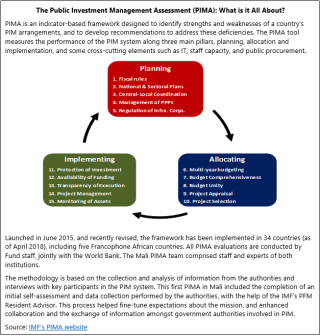
Posted by Benoit Taiclet, Gwénaëlle Suc, Nicolas Botton, Fabienne Mroczka, Onintsoa Raoilisoa, Pierre Roumegas, and Yemdaogo Tougma
Public investment is instrumental to achieve development objectives, particularly so in fragile and post-conflict countries which very often have rudimentary, or damaged infrastructure.
Although a key driver for economic growth in Mali, public investment spending has decreased overtime, undermining access to, and the quality of key infrastructure. As a long-standing policy under successive National Development and Poverty Reduction Plans, the Mali government has sought to increase its fiscal space to boost capital spending, as a means of fostering growth and development across the country.

In this context, the Mali government requested the IMF’s Fiscal Affairs Department to conduct a Public Investment Management Assessment (PIMA) , which is described in the Box below (Click on the box for a better image resolution).

The evaluation brought to light a generally robust Mali PIM institutional framework, which nevertheless falls below best practice in some areas. Overall, for a given amount of public investment, the amount and quality of infrastructure produced in Mali is 43 percent lower than in the most efficient countries. Identified gaps with best practice include poor coordination between central and regional entities, an incomplete PPP framework, weak oversight of public enterprises, and poor maintenance of public assets. There is also a need for capacity re-enforcement across many of the PIM institutions.
The evaluation team’s proposed recommendations and actions straddle four main priority areas: to strengthen the social-economic impact of investment expenditures; consolidate the investment effort; maintain existing infrastructure in the long term; and improve PIM governance.


Note: The posts on the IMF PFM Blog should not be reported as representing the views of the IMF. The views expressed are those of the authors and do not necessarily represent those of the IMF or IMF policy.







